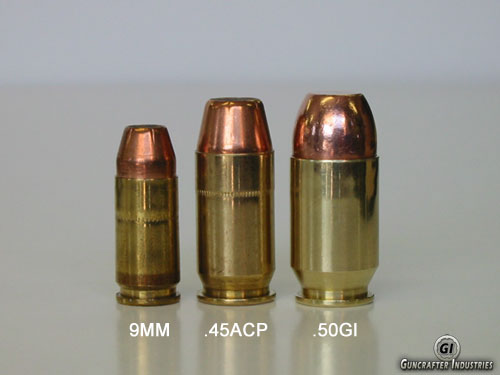
[snippage]
It is 100% standard-sized on the outside. It has a bull barrel, that is, no bushing, and this barrel kinda gives new meaning to the word bull barrel. It's bigger on the inside so it's bigger on the outside, and this is sort of a rule that runs throughout the gun—we're going from .452 diameter to .500 here, so there's a theme of everything's bigger by .048, or .024 per side. The barrel OD is bigger, so the slide bore is too. The rounds are fatter, so the magazine's wider, so the mag chute in the frame is wider, so the trigger bow is wider. The frame rails, where they pass over the mag chute, are milled off, since even on a .45 they are really thin there. I don't see them really being missed; slide to frame fit on this gun is great, although it has been one their later shop test mules and has 1500-2000 rounds through it.
The slide's breech face is standard .45 size, since the round features a rebated rim. Sights are Heinie night sights, some of the other bits look like Wilson, others I'm not sure and I don't really care anyway, long as they're good. The trigger is a 3-hole aluminum job with an OT screw, and the grips are dark OD-anodized Alumagrips. This is my first hands-on with these babies and they're very nice, in spite of the fact that I had already convinced myself that I wouldn't like metal as a grip material. They're very precise-looking, so they go well with the rest of the gun. This GI .50 is Parkerized; I think they all are. A couple of interesting features include a 20-LPI flat MSH (steel) with a flush lanyard attachment point. Checkering on the frontstrap is 20LPI and unique in that it only covers the middle 40% of the frontstrap. When I saw this in the pics I thought it was a little funky but getting my hands on it, it gives what I'm gonna guess is 85% of the stiction that a full-width job would give. I talked to the guy that does the checkering and he says it's less grabby on jacket linings and such. It's very nicely done, so it's not like they couldn't do it the conventional way if they wanted to. The gun has a 1- piece FLGR with the little bent-paperclip takedown hole, a single-sided safety that is extended but not huge, and a non-extended mag release. The magwell has a neatly done, subtle chamfer around it, pretty much as has become standard on mid-to-high end factory guns.
Anybody here ever handle 9mm all day and then put a couple .45's in your hand? That's what it feels like going from .45 ACP to having a couple of .50 GI rounds in your hand. When I first handled on of these fat little fellers, I was reminded of a favorite saying of one of the old Zap Comix characters: "Blimey mate, that's a whopper!"
[snippage]
The magazine is a real piece of work. It's very significant that the body is made from heat treated stainless (you can plainly see that it's been through an inert-gas bright heat treating process) that is .006 thicker that the steel used in a .45 magazine. .006 doesn't sound like much but that's about a 25% increase. The follower is machined from Delrin and has a heat treated steel insert where it contacts the slide stop. The removable floor plate is machined from, no wait, it is machined for cryin'-out-loud from steel, and Parkerized to match the gun. There are two small holes per side in the body to show full and when there are at least two rounds left. One of the reasons the Wilson magazines work so well is that they hold the rounds measurably higher than others (remember a couple years back when the design was improved? Guess who?). The GI mag also holds the rounds high and angled upward. The mag will not be a weak spot, that seems sure.
Bullet comparison pic:
